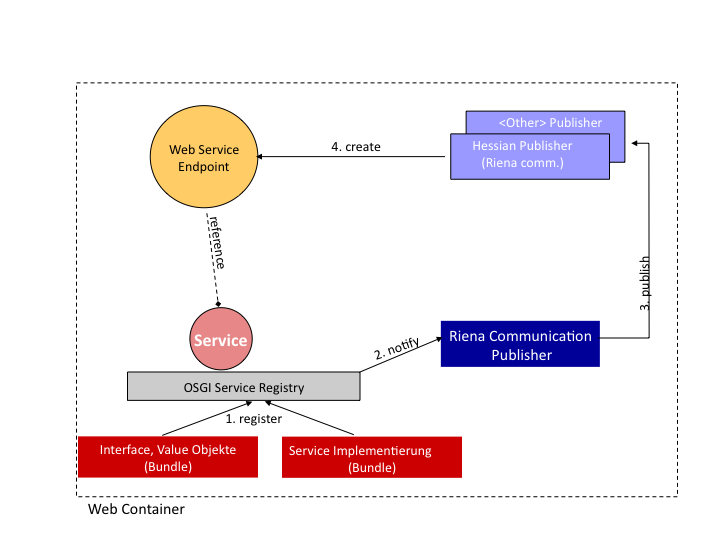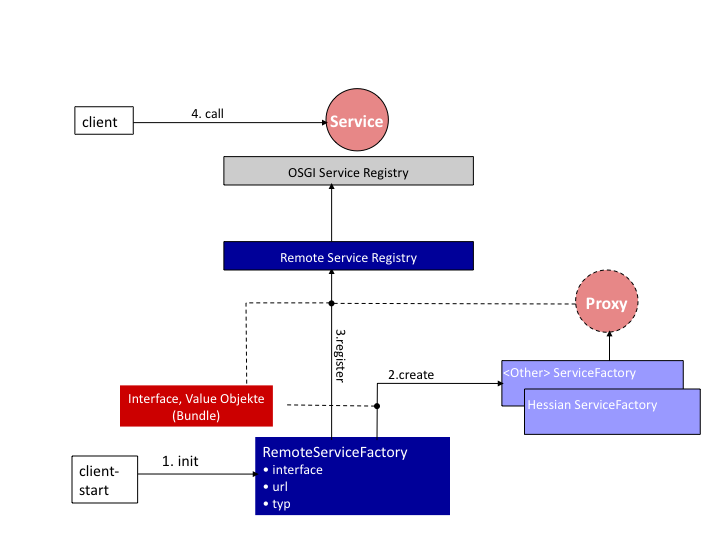Notice: this Wiki will be going read only early in 2024 and edits will no longer be possible. Please see: https://gitlab.eclipse.org/eclipsefdn/helpdesk/-/wikis/Wiki-shutdown-plan for the plan.
Difference between revisions of "Riena/Getting started with Remote Services"
m (typos, capitalization, etc.) |
|||
| Line 4: | Line 4: | ||
=== The Idea of Remote Services in Riena === | === The Idea of Remote Services in Riena === | ||
| − | Equinox and OSGi have already an established simple way for registered java components as OSGi services. These services maintain their own lifecycle. They can be looked up in the central OSGi service registry. | + | Equinox and OSGi have already an established simple way for registered java components as OSGi services. These services maintain their own lifecycle. They can be looked up in the central OSGi service registry. Afterwords, a method on the service can be invoked as on any other java instance. |
Riena makes OSGi services available outside the current JVM by publishing them as web service endpoint. This is as simple as adding new properties when registering the OSGi service. | Riena makes OSGi services available outside the current JVM by publishing them as web service endpoint. This is as simple as adding new properties when registering the OSGi service. | ||
| Line 44: | Line 44: | ||
[[Image:Riena_RemoteService_on_Server.png]] | [[Image:Riena_RemoteService_on_Server.png]] | ||
| − | <i>Note: The protocol property "hessian" is only indirectly translated into the path segment "/hessian". What really happens is that the Riena Communication Publisher asks the Hessian Publisher to publish the OSGi service. The Hessian Publisher chooses to add a path segment called /hessian before the actual Web Service | + | <i>Note: The protocol property "hessian" is only indirectly translated into the path segment "/hessian". What really happens is that the Riena Communication Publisher asks the Hessian Publisher to publish the OSGi service. The Hessian Publisher chooses to add a path segment called /hessian before the actual Web Service URL. So its not mandatory that the two values are the same or that a publisher adds a path segment for that matter. However this behaviour makes URLs more unique, since it avoids conflicts between publishers.</i> |
=== Accessing the remote OSGi Service === | === Accessing the remote OSGi Service === | ||
| Line 114: | Line 114: | ||
=== Starting / Stoping OSGi Services === | === Starting / Stoping OSGi Services === | ||
==== Starting ==== | ==== Starting ==== | ||
| − | Riena communication publishes an OSGi Service as Web Service Endpoint as soon as the bundle that contains the services is started. Say you use the sample as | + | Riena communication publishes an OSGi Service as Web Service Endpoint as soon as the bundle that contains the services is started. Say you use the sample as described above the status of the started bundles look like this: |
<pre> | <pre> | ||
ss | ss | ||
| Line 161: | Line 161: | ||
</pre> | </pre> | ||
<i>Note: And before you ask. It only displays the interface if client and server are on the same machine. We don't want to expose that kind of information in a production environment</i> | <i>Note: And before you ask. It only displays the interface if client and server are on the same machine. We don't want to expose that kind of information in a production environment</i> | ||
| − | <i>Note: There is a problem in the current implementation that the | + | <i>Note: There is a problem in the current implementation that the URL displayed in the console does not show the webservice port. So http://localhost/hessian/PingPongWS might also mean you have to enter http://localhost:8080/hessian/PingPongWS into your browser's url address field.</i> |
which is the default message if a Web Service Endpoint (hessian) is opened in the browser. | which is the default message if a Web Service Endpoint (hessian) is opened in the browser. | ||
| − | ==== | + | ==== Stopping ==== |
Say you stop the bundle that started the OSGi Service for this Web Service Endpoint | Say you stop the bundle that started the OSGi Service for this Web Service Endpoint | ||
<pre> | <pre> | ||
| Line 186: | Line 186: | ||
call received from browser, no remote service registered with this URL | call received from browser, no remote service registered with this URL | ||
</pre> | </pre> | ||
| − | No Web Service Endpoint for this | + | No Web Service Endpoint for this URL. |
Revision as of 20:58, 27 February 2008
Riena Project > Getting Started> Getting Started with Remote Service
Contents
Getting Started with Remote Service
The Idea of Remote Services in Riena
Equinox and OSGi have already an established simple way for registered java components as OSGi services. These services maintain their own lifecycle. They can be looked up in the central OSGi service registry. Afterwords, a method on the service can be invoked as on any other java instance.
Riena makes OSGi services available outside the current JVM by publishing them as web service endpoint. This is as simple as adding new properties when registering the OSGi service.
On the client that wants to remotely access such a service a proxy is registered as an OSGi service in the client JVM. So the component on the client that wants to use a remote OSGi service, calls the OSGi service in the local (client) JVM and the proxy transports the request and response between client and server. These client OSGi services with the embedded proxy are either created through an API (RemoteServiceFactory) or through Declarative Service (RemoteServiceBuilder).
Publishing an OSGi Service as Web Service
This example of a bundle activator shows how an OSGi service becomes a Web Service in Riena communication:
public class Activator implements BundleActivator {
private ServiceRegistration pingPongReg;
public void start(BundleContext context) throws Exception {
PingPong pingPong = new PingPong();
Hashtable<String, String> properties = new Hashtable<String, String>(3);
properties.put("riena.remote", "true");
properties.put("riena.remote.protocol", "hessian");
properties.put("riena.remote.path", "/PingPongWS");
pingPongReg = context.registerService(IPingPong.ID, pingPong, properties);
}
public void stop(BundleContext context) throws Exception {
pingPongReg.unregister();
pingPongReg = null;
}
}
Riena communication tracks all services as they are published (and unpublished). If it finds a property "riena.remote=true", then it tries to publish this OSGi service as web service.
In this case the PingPongService is made available under the URL "http://localhost/hessian/PingPongWS". If, for some reason, the Activators stop method is called and the service is unregistered, then also the web service endpoint is unpublished and therefore no longer available.
Here is a picture that illustrates the process:

Note: The protocol property "hessian" is only indirectly translated into the path segment "/hessian". What really happens is that the Riena Communication Publisher asks the Hessian Publisher to publish the OSGi service. The Hessian Publisher chooses to add a path segment called /hessian before the actual Web Service URL. So its not mandatory that the two values are the same or that a publisher adds a path segment for that matter. However this behaviour makes URLs more unique, since it avoids conflicts between publishers.
Accessing the remote OSGi Service
To access an OSGi Service that runs on the server from the client we have to create the corresponding web service proxy on the client and register it as OSGi Service. The code for that looks like this.
public class Activator implements BundleActivator {
private IRemoteServiceRegistration pingPongReg;
public void start(BundleContext context) throws Exception {
RemoteServiceFactory rsf = new RemoteServiceFactory();
String url = "http://localhost/hessian/PingPongWS";
String protocol = "hessian";
pingPongReg = rsf.createAndRegisterProxy(IPingPong.class, url, protocol);
}
public void stop(BundleContext context) throws Exception {
if (pingPongReg != null) {
pingPongReg.unregister();
pingPongReg = null;
}
}
}
A fixed URL is bound to a protocol and an interface. RemoteServiceFactory creates the proxy and registers the OSGi Service.
So once you have done that calling is as simple as calling a local OSGi Service:
public class Activator implements BundleActivator {
public void start(BundleContext context) throws Exception {
ServiceReference pingPongRef = context.getServiceReference(IPingPong.ID);
if (pingPongRef == null) {
return;
}
try {
IPingPong pingPong = (IPingPong) context.getService(pingPongRef);
if (pingPong == null) {
return;
}
Ping ping = new Ping();
ping.setText("I ping you and you pong me");
Pong pong = pingPong.ping(ping);
System.out.println("PingPong::Client:: " + pong);
} finally {
context.ungetService(pingPongRef);
}
}
public void stop(BundleContext context) throws Exception {
}
}
Here is a picture that illustrates what happens inside:

Note: IPingPong.ID is in this sample equivalent to IPingPong.class.getName().
Starting / Stoping OSGi Services
Starting
Riena communication publishes an OSGi Service as Web Service Endpoint as soon as the bundle that contains the services is started. Say you use the sample as described above the status of the started bundles look like this:
ss Framework is launched. id State Bundle 0 ACTIVE org.eclipse.osgi_3.3.0.v20070530 1 ACTIVE org.eclipse.core.contenttype_3.2.100.v20070319 2 ACTIVE org.eclipse.riena.communication.console_1.0.0.M1 3 ACTIVE org.eclipse.equinox.common_3.3.0.v20070426 4 ACTIVE org.eclipse.equinox.registry_3.3.0.v20070522 5 ACTIVE org.eclipse.core.jobs_3.3.0.v20070423 6 ACTIVE org.eclipse.riena.communication.core_1.0.0.M1 7 ACTIVE org.eclipse.osgi.services_3.1.200.v20070605 8 ACTIVE org.eclipse.riena.communication.publisher.hessian_1.0.0.M1 9 ACTIVE org.eclipse.equinox.cm_1.0.0.qualifier 10 ACTIVE org.apache.commons.logging_1.0.4.v200706111724 11 ACTIVE com.caucho.hessian_3.1.3 12 ACTIVE org.eclipse.equinox.http.registry_1.0.0.v20070608 13 ACTIVE org.apache.log4j_1.2.8.qualifier 14 ACTIVE org.eclipse.equinox.http.jetty_1.0.0.v20070607 15 ACTIVE org.eclipse.riena.communication.sample.pingpong.common_1.0.0.M1 16 ACTIVE org.eclipse.riena.communication.sample.pingpong.server_1.0.0.M1 17 ACTIVE org.eclipse.equinox.log_1.1.0.qualifier 18 ACTIVE javax.servlet_2.4.0.v200706111738 19 ACTIVE org.eclipse.riena.communication.publisher_1.0.0.M1 20 ACTIVE org.eclipse.core.runtime_3.3.100.v20070530 21 ACTIVE org.eclipse.riena.core_1.0.0.M1 22 ACTIVE org.eclipse.equinox.http.servlet_1.0.0.v20070606 23 ACTIVE org.mortbay.jetty_5.1.11.v200706111724 24 ACTIVE org.eclipse.core.runtime.compatibility.auth_3.2.100.v20070502 25 ACTIVE org.eclipse.equinox.preferences_3.2.100.v20070522 26 ACTIVE org.eclipse.equinox.app_1.0.0.v20070606
While starting one of the OSGi Services that was published triggered this debug message in the console:
Riena::ServicePublishEventDispatcher:: DEBUG: service endpoints count: 1 Riena:Communication::HessianRemoteServicePublisher:: DEBUG: published web service. protocol=hessian, url=http://localhost/hessian/PingPongWS, interface=org.eclipse.riena.communication.sample.pingpong.common.IPingPong
So clicking on this link [http://localhost/hessian/PingPongWS] will open a page in the browser that says something like this:
calls protocol=hessian, url=http://192.168.14.51/hessian/PingPongWS, interface=org.eclipse.riena.communication.sample.pingpong.common.IPingPong
Note: And before you ask. It only displays the interface if client and server are on the same machine. We don't want to expose that kind of information in a production environment Note: There is a problem in the current implementation that the URL displayed in the console does not show the webservice port. So http://localhost/hessian/PingPongWS might also mean you have to enter http://localhost:8080/hessian/PingPongWS into your browser's url address field. which is the default message if a Web Service Endpoint (hessian) is opened in the browser.
Stopping
Say you stop the bundle that started the OSGi Service for this Web Service Endpoint
osgi> stop 16
stops the OSGi service and Riena communication automatically unpublishes the Web Service Endpoint
Riena:communication::HessianRemoteServicePublisher:: DEBUG: unpublished web service. protocol=hessian, url=http://localhost/hessian/PingPongWS, interface=org.eclipse.riena.communication.sample.pingpong.common.IPingPong Riena:communication::HessianRemoteServicePublisher:: DEBUG: web service count: 1 Riena::ServicePublisherHessian:: DEBUG: service endpoints count: 1
> ss
... 16 RESOLVED org.eclipse.riena.communication.sample.pingpong.server_1.0.0.M1 ...
Clicking on this link [http://localhost/hessian/PingPongWS] again shows:
call received from browser, no remote service registered with this URL
No Web Service Endpoint for this URL.
